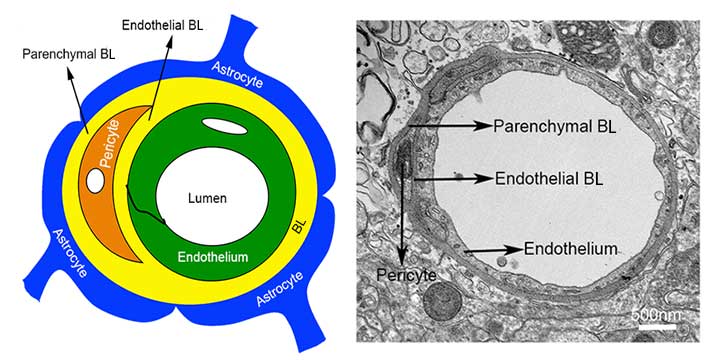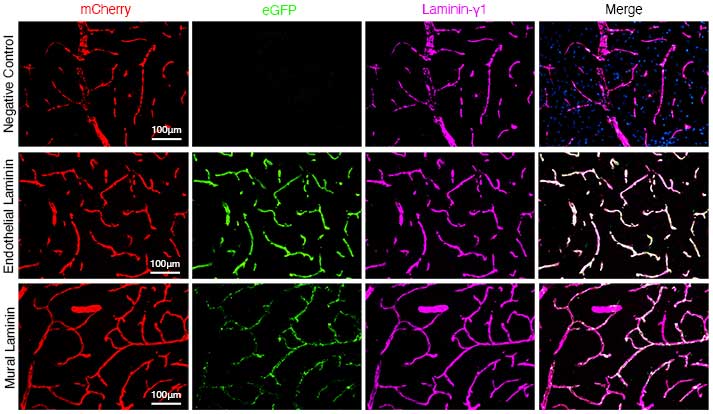Research

Overview
The blood-brain barrier (BBB), a dynamic structure located at the interface of the CNS and circulation system, plays an important role in almost all neurological disorders. For example, BBB disruption occurs prior to dementia and contributes to the onset/development of Alzheimer’s disease. Although how various cell types affect BBB integrity is well-studied, the function of the basal lamina (non-cellular constituent of the BBB) remains largely unknown. We aim to answer this important question and fill the gap of knowledge by targeting laminin, a major component of the basal lamina. There are four major projects in our laboratory.
-
Laminin is a trimeric protein with many isoforms. Interestingly, different cell types synthesize distinct laminin isoforms. We have found that astrocyte-derived laminin actively maintains BBB integrity via regulating mural cell differentiation; endothelial laminin regulates BBB integrity mainly via transcytosis; and pericyte-derived laminin contributes to BBB integrity in an age-dependent manner. These results suggest that distinct laminin isoforms differentially regulate BBB integrity.
-
Based on laminin’s function in BBB maintenance, we hypothesize that laminin may affect the pathogenesis and outcomes of various neurological disorders, including stroke and Alzheimer’s disease. We have recently shown that ablation of mural cell-derived laminin-γ1 or endothelial laminin-α5 aggravates hemorrhagic brain injury, while loss of mural cell-derived laminin-α5 attenuates ischemic brain injury. These findings pave the way for developing laminin-based therapies in stroke. We are currently investigating how loss of laminin affects Alzheimer’s disease.
-
Laminin expression and turnover profiles in the CNS remain unknown. This is mainly due to the large number of laminin isoforms and the lack of research tools to accurately examine each cell type-derived laminin. We are developing innovative laminin reporter mouse lines, which allow investigation of laminin expression and turnover in a cell-specific and Cre-dependent manner. Using these genetic tools, we hope to generate a comprehensive expression/turnover profile for each cell type-derived laminin in the CNS. This information will shed light on an understudied yet extremely important field and open doors for new research.
-
Pericytes and fibroblasts are two less studied cell populations in the CNS. Their biology and functions under physiological and pathological conditions are mostly unclear. By using novel genetic models, we are able to selectively ablate these cells. We are characterizing the phenotypes of the resulting mice with or without brain injury and exploring the underlying molecular mechanisms. These findings will uncover the functional significance of pericytes and fibroblasts in brain homeostasis and neurological disorders.
Selected Publications
Yao Yao, Stella E. Tsirka. The C terminus of mouse monocyte chemoattractant protein 1 (MCP1) mediates MCP1 dimerization while blocking its chemotactic potency. The Journal of biological chemistry. 2010; 285(41): 31509-16.
https://www.ncbi.nlm.nih.gov/pubmed/20682771
Yao Yao, Stella E. Tsirka. The CCL2-CCR2 system affects the progression and clearance of intracerebral hemorrhage. Glia. 2012; 60(6): 908-18.
https://www.ncbi.nlm.nih.gov/pubmed/22419223
Yao Yao, Zulin Chen, Erin H. Norris, Sidney Strickland. Astrocytic laminin regulates pericyte differentiation and maintains blood brain barrier integrity. Nature communications. 2014; 5: 3413.
https://www.ncbi.nlm.nih.gov/pubmed/24583950
Yao Yao, Erin H. Norris, Christopher E. Mason, Sidney Strickland. Laminin regulates PDGFRβ(+) cell stemness and muscle development. Nature communications. 2016; 7: 11415.
https://www.ncbi.nlm.nih.gov/pubmed/27138650
Abhijit Nirwane, Yao Yao. Laminins and their receptors in the CNS. Biological reviews of the Cambridge Philosophical Society. 2018; 94(1): 283-306.
https://www.ncbi.nlm.nih.gov/pubmed/30073746
Yao Yao. Basement membrane and stroke. Journal of Cerebral Blood Flow and Metabolism. 2019; 39(1): 3-19.
https://www.ncbi.nlm.nih.gov/pubmed/30226080
Jyoti Gautam, Lingling Xu, Abhijit Nirwane, Benjamin Nguyen, Yao Yao. Loss of mural cell-derived laminin aggravates hemorrhagic brain injury. Journal of neuroinflammation. 2020; 17(1): 103.
https://www.ncbi.nlm.nih.gov/pubmed/32252790
Minkyung Kang, Yao Yao. Basement Membrane Changes in Ischemic Stroke. Stroke. 2020; 51(4): 1344-1352.
https://www.ncbi.nlm.nih.gov/pubmed/32122290
Lingling Xu, Yao Yao. Central Nervous System Fibroblast-Like Cells in Stroke and Other Neurological Disorders.Stroke. 2021; 52(7): 2456-2464.
https://www.ncbi.nlm.nih.gov/pubmed/33940953



